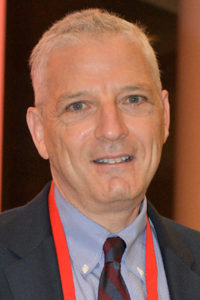
Disruption of circadian rhythm by shift work, rotating work schedules, jet lag, disease, and other causes has long been recognized as contributing to obesity and other metabolic dysfunctions. Research is beginning to unravel the genetic, environmental, and epigenetic mechanisms by which body clocks in the brain, liver, muscle, and adipose tissue act and interact to regulate or dysregulate metabolism.
“Internal and external factors can all reset internal clocks, including the liver clock,” said Dongyin Guan, PhD, Assistant Professor of Endocrinology and of Molecular & Cellular Biology, Baylor College of Medicine. “You can have environmental perturbations such as obesity, genetic perturbations such as mutations, and combinations of the two.”
Dr. Guan opened Zeitgebers (Time-keepers) of Metabolic Health—Resetting the Circadian Clock on Tuesday, June 7, with an exploration of the molecular mechanisms known to affect the circadian rhythms of liver function. The session was livestreamed and can be viewed on-demand by registered meeting participants at ADA2022.org. If you haven’t registered for the 82nd Scientific Sessions, register today to access the valuable meeting content.
Environmental factors such as obesity can act as epigenomic drivers to alter gene transcription and regulation, which in turn alters metabolism, homeostasis, and health. The ultimate goal of understanding the interplay between environment, genes, and circadian rhythm is to move medicine into the fourth dimension with time-related health interventions such as chrono-pharmacology and chrono-nutrition, Dr. Guan said.

In mouse models, diet-induced obesity (DIO) disrupts the hepatic circadian clock. Dr. Guan’s lab found that DIO induces genome-wide remodeling of circadian enhancer activity similar to disruptions seen in chronic cold temperatures. DIO alters the expression of non-canonical clock genes regulating de novo lipogenesis (DNL) and regulates fatty acid oxidation (FAO).
In the healthy liver, DNL inhibits FAO. But in the fatty liver, DNL and FAO are synchronized, leading to increased obesity without affecting the core body clock. Dr. Guan said non-canonical genes regulating circadian rhythm in the liver and other organs may be useful therapeutic targets. These non-canonical clock regulators are tissue-specific as well as specific to physiologic and pathologic contexts.
All tissues have their own internal timers, clocks that anticipate the Earth’s rotation, said Joseph T. Bass, MD, PhD, Director of the Center for Diabetes and Metabolism, Chief of Endocrinology, and the Charles F. Kettering Professor of Medicine, Northwestern University Feinberg School of Medicine.
“These are essentially mechanisms to capture energy,” Dr. Bass explained. “Clocks have evolved to capture and store energy during one phase of the Earth’s rotation and release and utilize energy during other phases of the Earth’s rotation.”

Those tissue clocks are not fixed. Environmental signals such as light and darkness can affect the clock. So do high-fat diets and obesity. Some signals act on specific tissues, such as the liver, while others can affect the core clock that is more directly regulated by canonical clock genes.
“It is not just what we inherit,” Dr. Bass said. “It’s also about the environment we inhabit and what we might be able to put together in a beneficial way. The epigenetic state controls circadian behavior and metabolism.”
One of the most beneficial changes for people with type 2 diabetes is adding exercise. But the benefit is not just how much exercise, but also when. When it comes to improving glucose metabolism, exercise in the afternoon is more beneficial than the same amount of exercise in the morning.
One effect of the intrinsic circadian rhythm in skeletal muscle is to regulate mitochondrial function, explained Juleen R. Zierath, PhD, Professor of Medicine, Karolinska, Stockholm, Sweden, and University of Copenhagen, Denmark. Analysis of human skeletal muscle shows that high-intensity exercise in the morning relies on carbohydrate metabolism and tends to elevate blood glucose levels. The same exercise in the afternoon relies more on lipid metabolism and is glucose-lowering.

Afternoon training improves glucose sensitivity, increases fat loss, and increases work performance, Dr. Zierath reported. Continuous glucose monitoring also revealed that afternoon training reduces nocturnal blood glucose levels.
“In obesity and type 2 diabetes, afternoon training may be more helpful in promoting metabolic change,” she said. “This may be a factor to consider when prescribing exercise.”
Adipose tissue metabolism can also be reset by diet. In obese mice and humans, adipose cells become hypertrophic, releasing lipids into the circulation to accumulate in the liver and other organs that do not normally store fat, leading to type 2 diabetes, said Kristin Eckel-Mahan, PhD, Associate Professor, Center for Metabolic and Degenerative Diseases, McGovern Medical School at the University of Texas Health Science Center.
Adipose precursor cells (APCs) exhibit a diurnal proliferation cycle. In normal adipose tissue, this cycle acts to maintain energy homeostasis. In mice, a high-fat diet disrupts that circadian rhythm. APCs proliferate throughout the cycle, leading to exhaustion and hypertrophy.
“We think that not just the quality of the diet counts, but also the timing,” Dr. Eckel-Mahan said. “We see the same patterns in humans looking at adipose tissue samples from lean and obese individuals. If you disrupt the circadian clock, you see elevated expression of proliferation genes in fat, which leads to abnormal fat production, even in normal dietary intake.”
[sub-post-content]